Roborovski dwarf hamsters are fun-loving, fast, and adorable miniature creatures that usually grow to be four to six centimeters in length. They love to eat and sleep but are really active too. They have a reputation for being much more lively than other hamster species. In addition, their average lifespan is slightly longer at around three years with the occasional fellow reaching four years.If you’re considering a Robo dwarf hamster as a pet, then you should first learn the best ways to care for one.
How to Care for Roborovski Hamsters
1Preparing and Maintaining Your Hamster’s Habitat
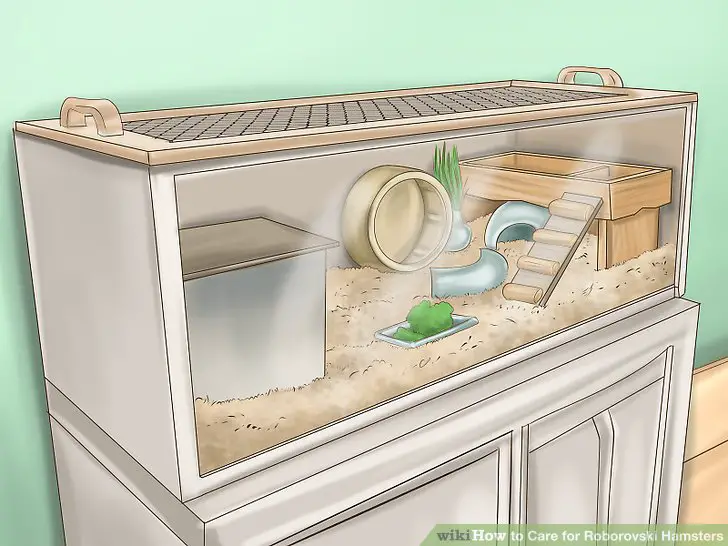
1Purchase a suitable habitat. The minimum cage requirement is 450 square inches, but you should always go bigger. You should set up a home for your hamster before buying one. You can use a wire cage as long as it has a solid bottom to protect your hamster’s feet and the mesh is small enough that your hamster can’t escape or get stuck. You can also use a 20-gallon aquarium—just make sure it has a wire mesh cover to allow ventilation.
- Unlike other solitary hamster species, Roborovski hamsters can live in pairs. Just remember to have a separate cage available, incase the pair does not work out. You should always separate them immediately, if they fight. If you plan to have two, try to purchase them from the same litter. You’ll have fewer potential problems if they grow up together. You should also ensure that both hamsters are the same sex to avoid them breeding and producing large litters.
- Be aware that even hamsters raised together from a young age can still fall out and fight. You should avoid large-scale hamster colonies to prevent the chances of this.
- Never house Roborovski hamsters with other species of hamster—or other species of animal—as they will become territorial and fight.
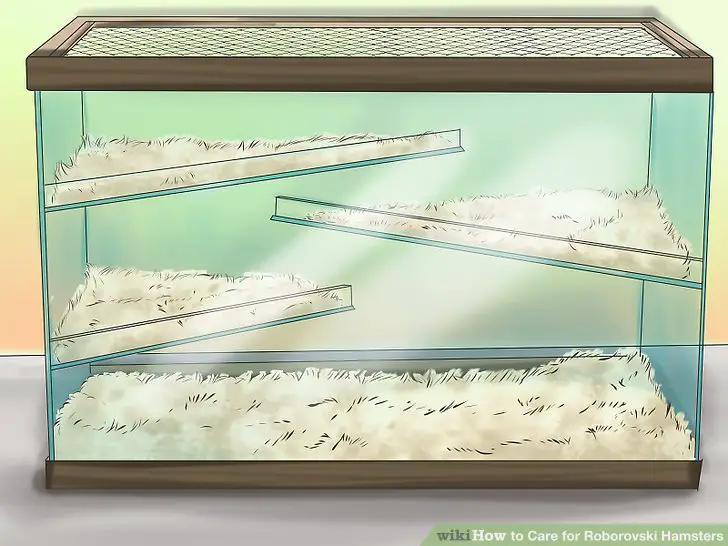
2Place bedding into the habitat. Roborovski hamsters love to burrow, hide, and dig, so make sure you put plenty of bedding into the habitat. A layer of about three inches will be fine. A generous layer of four to five inches will certainly be appreciated.
- Soft white cellulose fiber (Carefresh) and aspen shavings are both suitable choices for your hamster. If you choose wood shavings never use pine or cedar as they can cause a number of health problems and contain harmful oils that are toxic to hamsters.
- Avoid bedding that contains long fibers. Synthetic forms of bedding—such as those made of polyester fibers—are notorious for tangling around limbs and cutting off circulation.
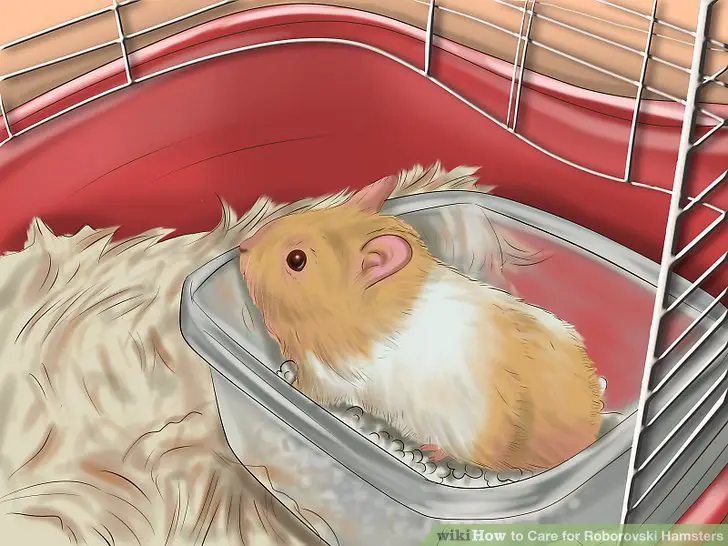
3Include a litter tray. Small plastic trays with a hood are available. They are designed to fit in the corner of a hamster cage. You put special hamster litter inside, which helps to neutralize odors. Most hamsters will use these quite happily instead of soiling their cages. This is optional.
- Clean the litter pan regularly since your hamster will be put off using it if the area is too soiled.
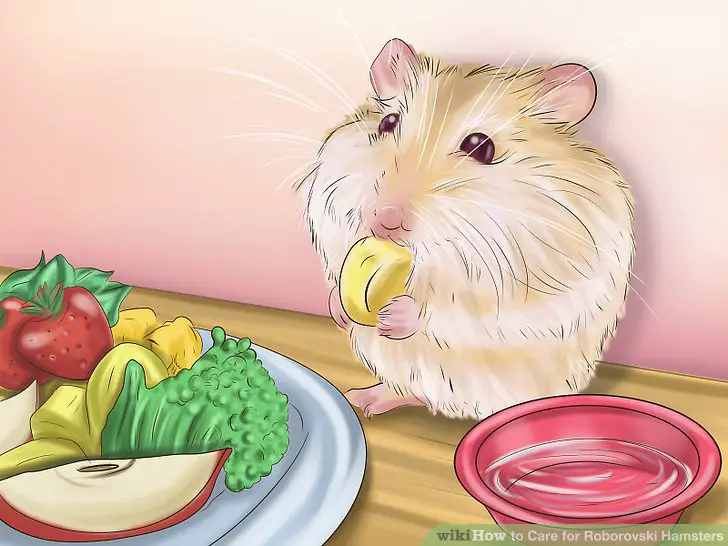
AProvide food and water. Your hamster will thrive on a steady diet of rodent chow (blocks) and a good food, such as Hazel Hamster, or Vitakraft. Pellets or just one type of food lacks variety and nutrition. Keep in mind that some hamster foods like Vitakraft lack in protein, so you should feed hamsters eggs, and food that has protein in it. You can also provide seed mixes with pellets, grains, seeds, and dried vegetables. However, do not provide seed mixes alone since your hamster can eat selectively around the tasty bits, which leads to an imbalanced diet.
- A hamster should have about 1.5 teaspoons of pellets or blocks, or as feeding directions instruct.
- Two to three times a week, you can also provide a bite-sized amount of fresh fruit and vegetables for your hamster. Consider carrots, lettuce, spinach, and apples. Scatter them around the cage to let your hamster forage for them.
- Never feed your hamster onions, uncooked beans, chocolate, or any junk food since it can be toxic to the animal.
- Provide fresh water daily in an inverted bottle with a sipping tube that attaches to the cage low enough for your dwarf hamster to reach it. This will prevent your hamster from accidentally soiling his or her water supply and getting sick.
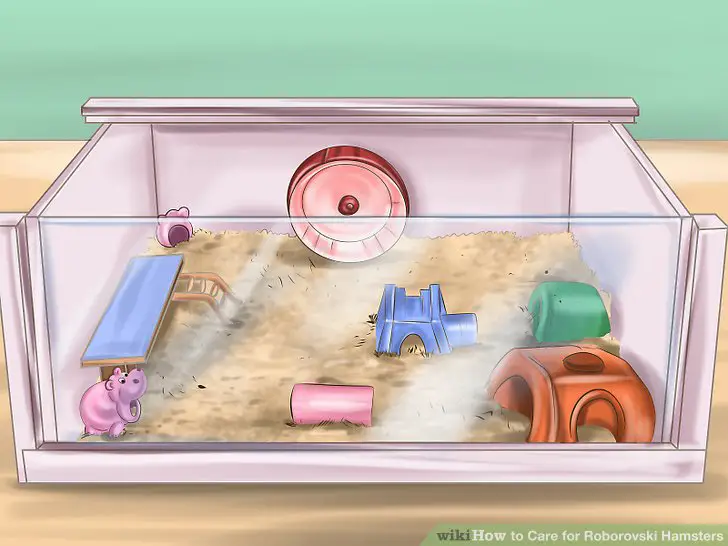
5Place toys and an exercise wheel in the habitat. Choose a wheel with a solid outer tread plate since wired wheels can injure your hamster’s feet. When the hamster is in the wheel make sure his back is straight and that he does not have to bend his back backwards in order to fit in under the central axle as this leads to back problems. Allow your hamster to exercise in the wheel daily, but remove it from the habitat when you aren’t supervising to prevent the chance of injury.
- Toys for a Roborovski hamster include tubes, tunnels, hideouts, toilet paper rolls, wooden chews (these will keep your pet’s teeth trimmed, as the teeth in hamsters do not stop growing), and bridges. Avoid anything made of soft plastic that can create a choking hazard.
- Never use any pet store toy that has fluff or filling of any kind.Your hamster will most likely store it in his or her mouth to use it for a nest, but the fluff is harmful to a hamster’s system and can create a choking hazard. Try using toilet paper instead as this is safe for your hamster.
- Swap toys out of the habitat every few days. By rotating them, you can help maintain your hamster’s interest in the toys.
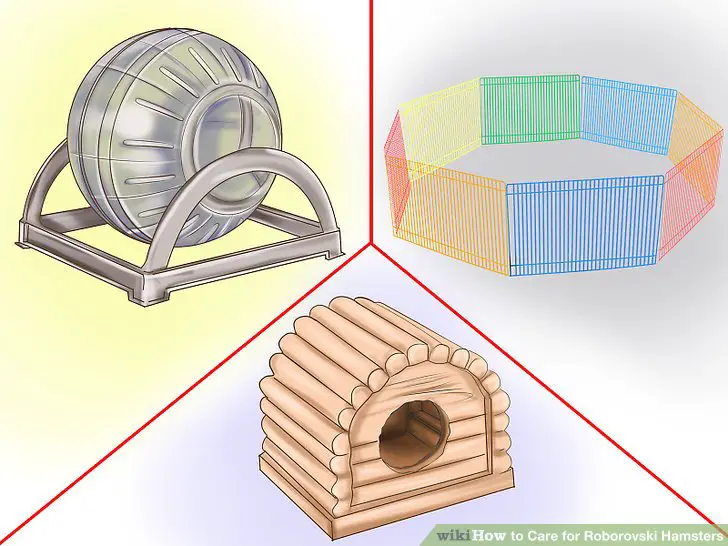
6Consider purchasing enrichment items for outside the habitat. Roborovski hamsters are naturally curious little animals, and they relish the chance to leave their enclosures to explore what lies beyond their habitats.
- An exercise ball is a fantastic way to let your hamster run all over the house without having to worry about injury or escape. Just make sure to keep the ball on the ground floor of multilevel homes to avoid dangerous tumbles down stairs.
- Hamster playpens are also available on the market, and these allow plenty of space to provide toys and treats. You can also use a very large storage bin as an alternative. Don’t use cardboard boxes, though, because hamsters can chew holes in them and escape.
- Hamsters love to explore rooms, so if you decide to allow your pet to do so, remove all dangerous items and make sure the room is inescapable. Roborovski hamsters can fit through gaps as small as their skulls. Always supervise your hamster when he or she is out of the habitat.
- No matter what type of play area you use for your pet, fill it with toys, hiding places, and some tasty treats. You need playing areas to keep your hamster active and stimulated.
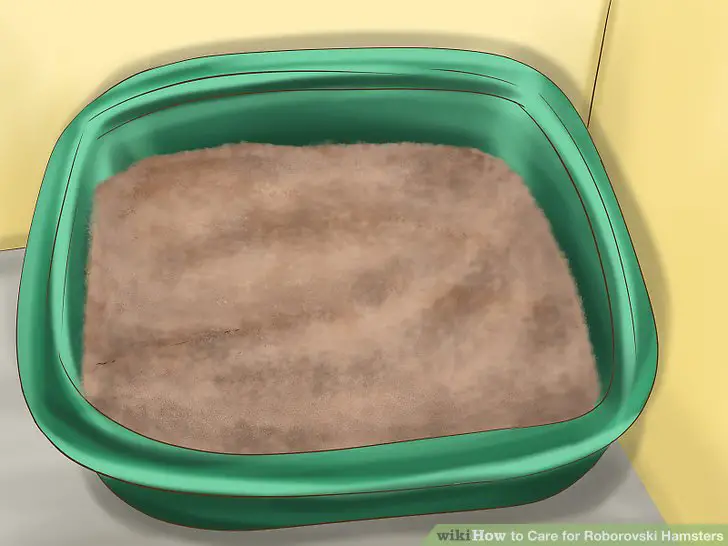
7Buy bathing materials. Robo hamsters also love rolling around in a container full of bathing sand. Purchase chinchilla sand (not chinchilla dust, which is very harmful). Select a long dish or bowl (preferably plastic) and fill it up before allowing your hamster to roll around in it. Roborovski hamsters enjoy a sand bath, but water will stress them out, so do not try to give your hamster a water bath.
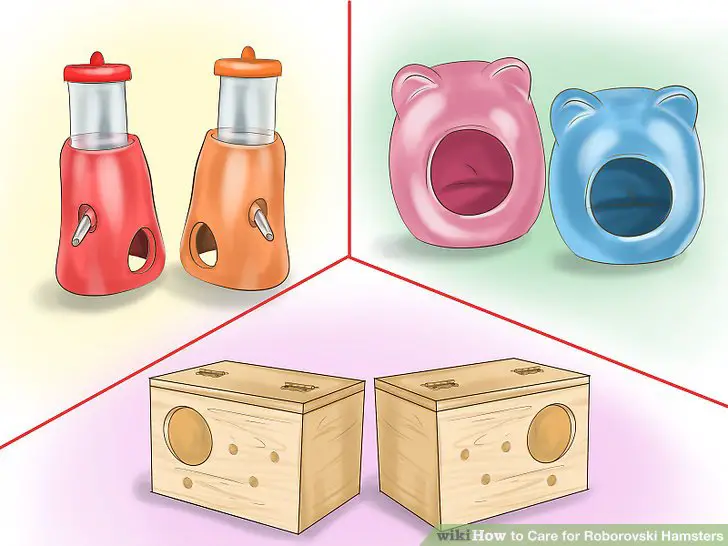
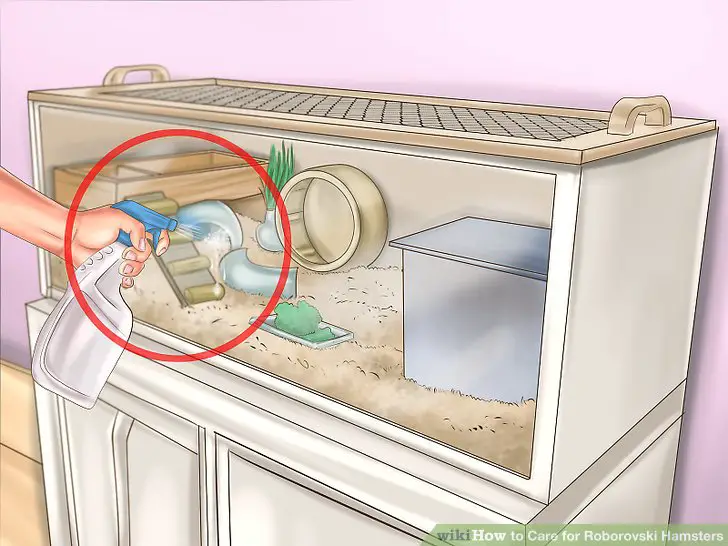
Clean the habitat once a week. Once a week, remove everything from the habitat and clean it using hot water. You can use a little vinegar on smelly areas, but ensure that you rinse the areas thoroughly after using it. Fill the cage with fresh bedding as you put it back together.
- Don’t forget to give all of your hamster’s toys and exercise wheel a scrub as well when you clean the habitat.
2Purchasing a Robo Dwarf Hamster
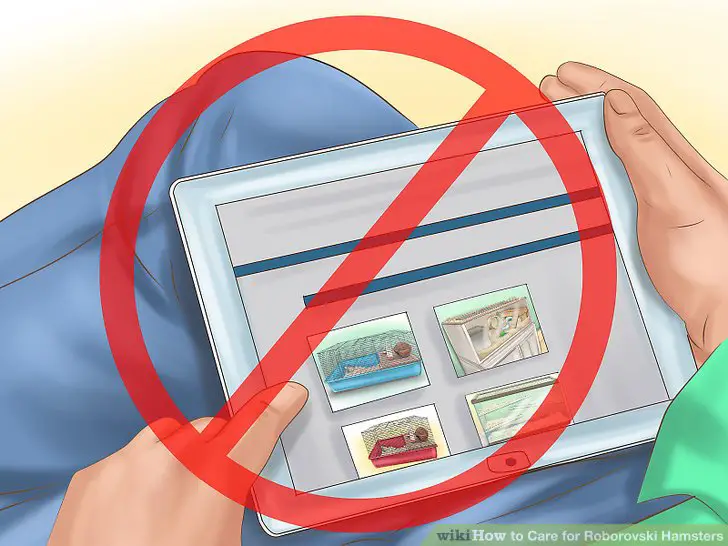
1Do not buy online. Once you’ve set up your hamster’s habitat, you’re ready to bring the hamster home with you. Make sure you purchase from a reputable pet store in person. Do not buy online since you want to take a good look at your hamster before purchasing. Adopting is recommended, you are giving hamsters a second chance at life.

2Go to the pet store in the late afternoon or early evening. Robo hamsters are most active at night, so you’ll get the best look at your hamster if you visit the pet store shortly before it closes. If you go during the day, the hamster will likely be sleeping.
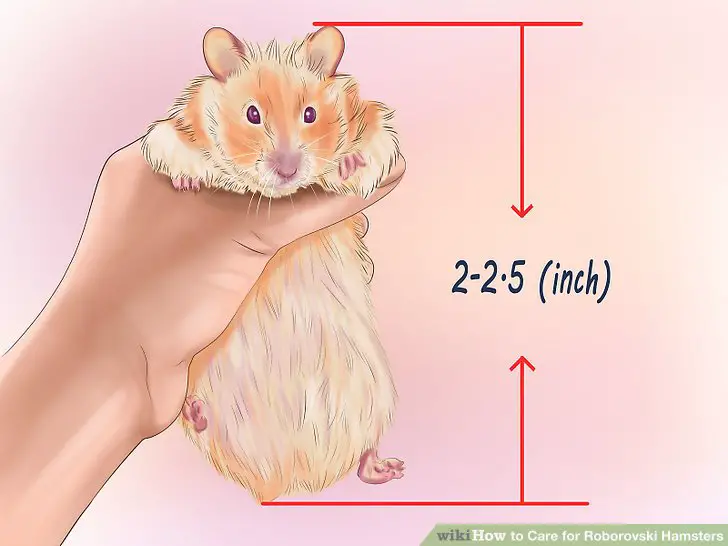
3Choose a young hamster. Ideally, you want a young hamster that is only four to six weeks old. An adult hamster will be between 2-2.5” long, so pick a youngster measuring less than two inches.

4Look for signs of a healthy hamster. The hamster should be round, lively, active, and alert. The eyes should be clear, ears erect, and the fur should be dry.
- Don’t buy any hamster at a pet shop if one of them has wet fur around its rump. This is a sign of a disease called wet tail, and it has probably spread to the other hamsters if you see it in one. If any fur is wet at all, avoid buying hamsters from that store.

5Make sure the pet store separates male and female hamsters. A responsible shop will keep male and female hamsters separate to prevent breeding. You don’t want to bring a hamster home and end up having her give birth to a large litter a week later. Reputable shops should also guarantee the sex of their hamsters, allowing you to purchase Robo hamsters in pairs without fear of breeding.
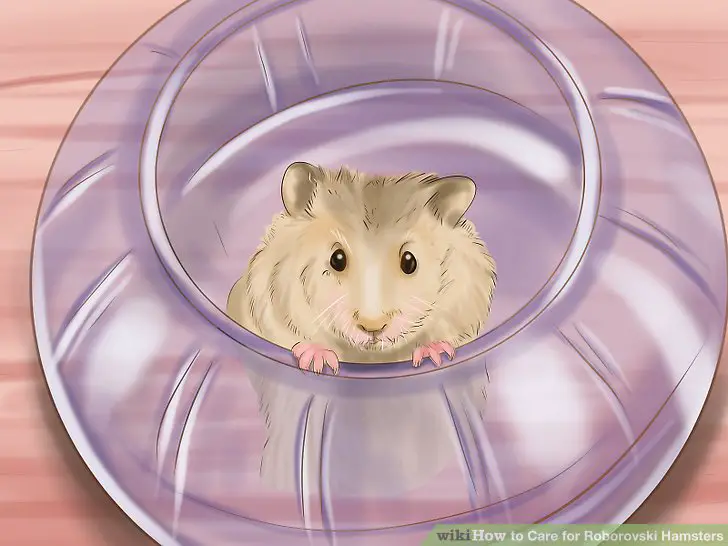
6Request to put your hand in the hamster enclosure. You want to test the behavior toward people of the hamsters in the enclosure. They’ll likely all run away from your hand initially, but choose a hamster that peeks out and sniffs at your hand after the initial hiding. Hamsters displaying this behavior will be easier to handle and less scared of you later on.
- Roborovski hamsters are naturally nervous and flighty, so you’ll need to give them some time before one will come out and investigate you.
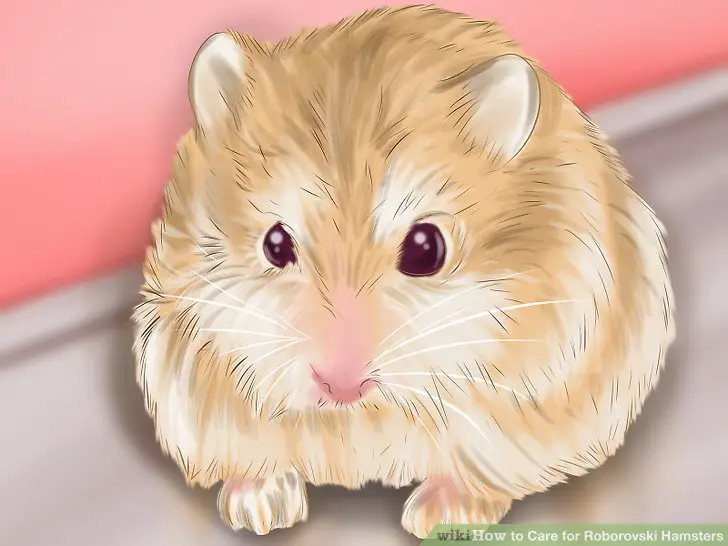
7Purchase your hamster. Once you’ve taken all of these steps into consideration, you’re ready to pick the best candidate. Purchase the Robo hamster that displays these qualities and melts your heart.
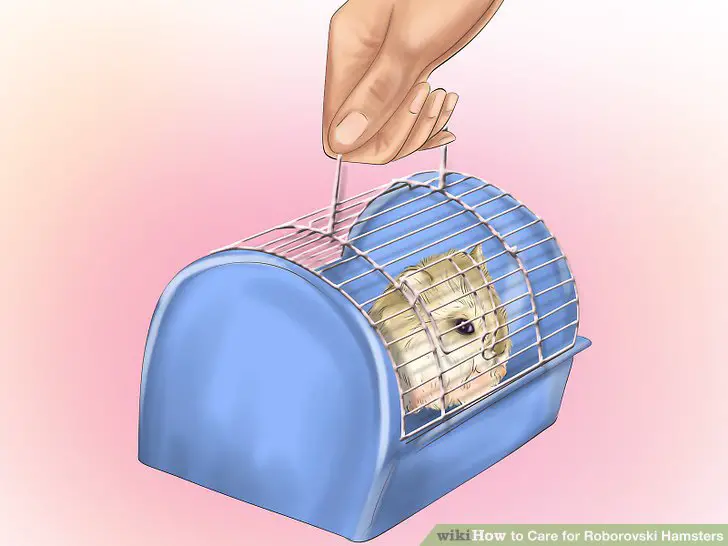
8Obtain a small traveling kit. The pet store may offer a traveling kit to help you transport your new hamster home with you. If not, be prepared to bring something from home with some bedding, a little food, and a few toys. The goal is to make the journey as stress free for the hamster as possible.
- Avoid using anything made of cardboard since the hamster can chew through it and escape.
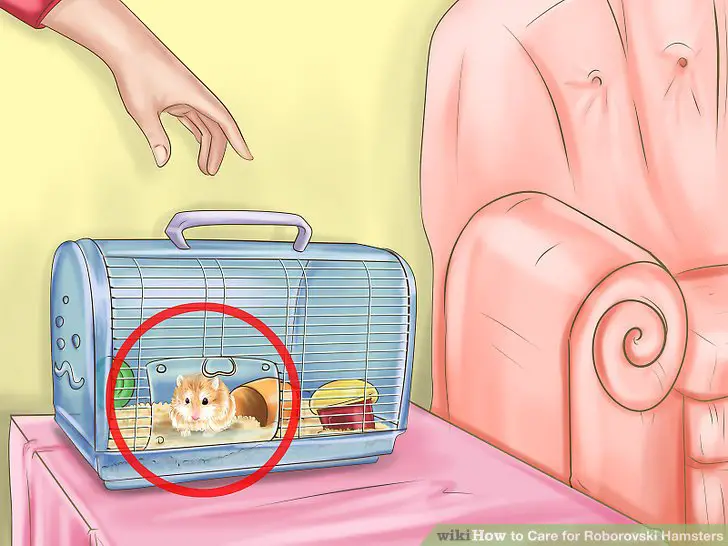
9Bring your hamster home as quickly and safely as possible. Your new hamster will be very stressed after being handled and removed from its familiar enclosure. Go straight home without making other stops and place your new pet into the already set up habitat slowly and gently.
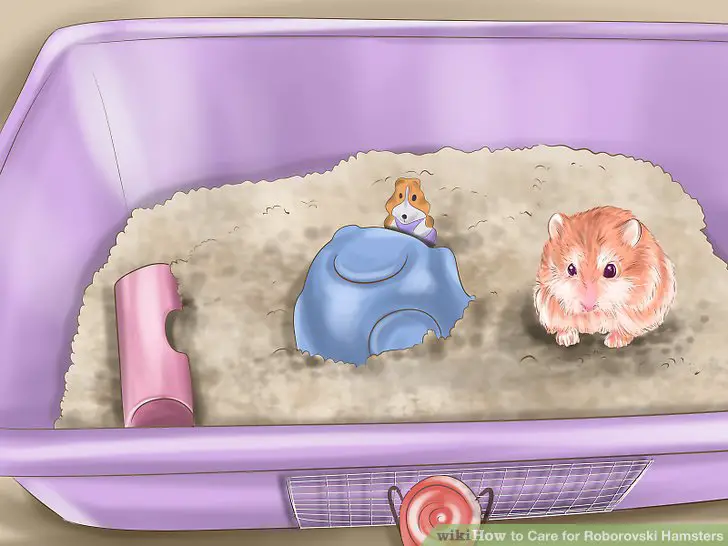
10Leave your new Roborovski hamster alone for the first several days. You need to let your new hamster adapt to his or her new habitat and surroundings before you attempt to handle or tame the hamster. Keep in mind that some hamsters might need more time to adjust to their new home. You should have enough food, water, and toys in the habitat for the first few days, although you’ll soon need to start changing food, water, and toys daily.
- Cover the aquarium with a light cloth to allow your new pet to adjust to and explore its new habitat in privacy. This is the crucial recovery and adjustment period, so it will take longer if you disturb the hamster.
- If there are friends, guests, and/or children in the house, make sure they know not to go near the hamster’s enclosure. You’ll probably want to watch your hamster explore its new home, but Roborovski hamsters are especially nervous and will hide and become very stressed, so resist the temptation for the first few days.
3Taming Your Roborovski Hamster
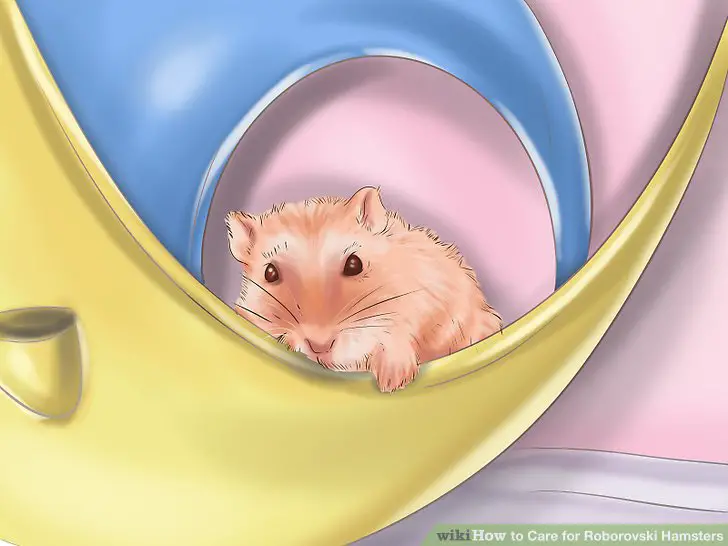
1Ensure your hamster is awake before reaching into the habitat. During the taming process—and even after when your hamster is comfortable with you—always make sure your hamster is awake before you try to handle him or her. A sleepy hamster is disorientated and may nip if feeling grumpy or annoyed. To tame a hamster, put a treat in your hand and give it to your hamster. If it runs away, try again later. Once your hamster is comfortable after a few days of taking treats, put it in your palm this time. He/she will probably sit in your hand and eat it. When he is comfortable sitting in your hand, lift him up a few inches, and put him back down. Repeat process for the next few days, until he gets used to the feeling of lifting. Then try lifting him for longer periods of time, then higher, then out of the cage. Robo hamsters are very timid, so it might take a while to tame him. It is very difficult to tame them, so don’t be surprised when taming doesn’t go well.
- You should always wash your hands before and after reaching into the habitat or handling your hamster as well. They have poor eyesight, and smelling food on your fingers can lead to an accidental nip as well.

2Acclimate your hamster to your daily habitat chores. After several days, you can start going about the daily maintenance of your hamster’s habitat. Speak softly to alert your Roborovski hamster of your presence. Start the daily chores—removing old food, toys, and soiled bedding and placing in new food, and a bunch of new toys. Change the water from the water bottle as well.
- Doing the daily chores will get your hamster used to your hand being in the habitat. Use slow and careful movements at first.

3Allow your hamster to sniff your hand while in the habitat. It’s typical for your new hamster to sniff your hand and then run away again. Don’t try to handle the hamster yet just because he or she will sniff your hand. Try offering treats as well, but have patience and allow the hamster to set the pace. Don’t try to force the behavior.
- Another option to help tame your hamster is to scoop him or her up in a shoebox or another small box that the hamster cannot escape. Place your hand flat in the box and allow the hamster to sniff at you that way. If the hamster can’t simply hide, he or she will be more likely to approach you.
- If your hamster runs away and hides, squeaks if you try to touch it, or rolls on its back and/or bares its teeth, then the pet is only feeling stressed, and you should try again with the taming techniques later.
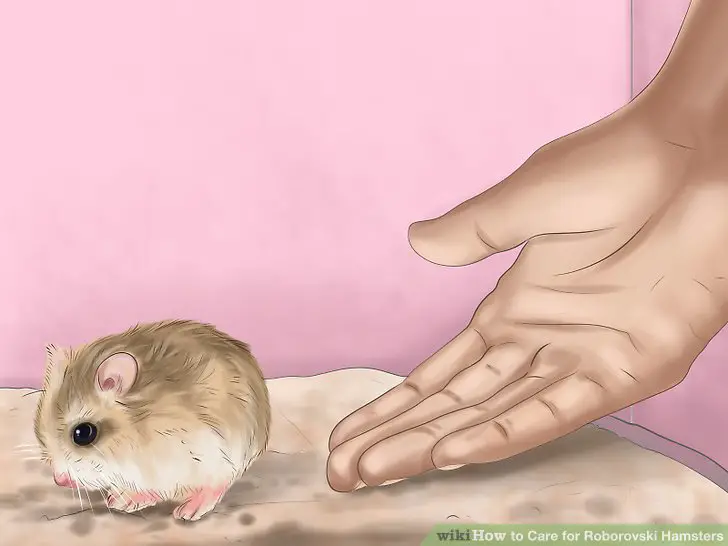
4Respect your hamster’s individual personality. Remember, all hamsters have different personalities. If your hamster is interested in you after a couple days, that’s great. If your hamster still shows no affection to you after a month of training, then your hamster may not ever develop a fondness for human interaction, and you need to respect this. You can still enjoy your hamster by watching your pet play in its playpens and/or exercise ball.

5Play with your hamster. Once your hamster no longer fears you, you can bring it into a designated play area of your house. Roborovski hamsters love playtime outside of their habitats, so you’ll be pleasing your pet and keeping it stimulated by letting it run around.
- Supervise your hamster if it is allowed to explore a room. Your hamster should spend at least an hour or two outside of the habitat daily whether in an exercise ball, a playpen, or running around a secure space under your supervision. Always switch the toys in the play areas just as you should in its habitat.
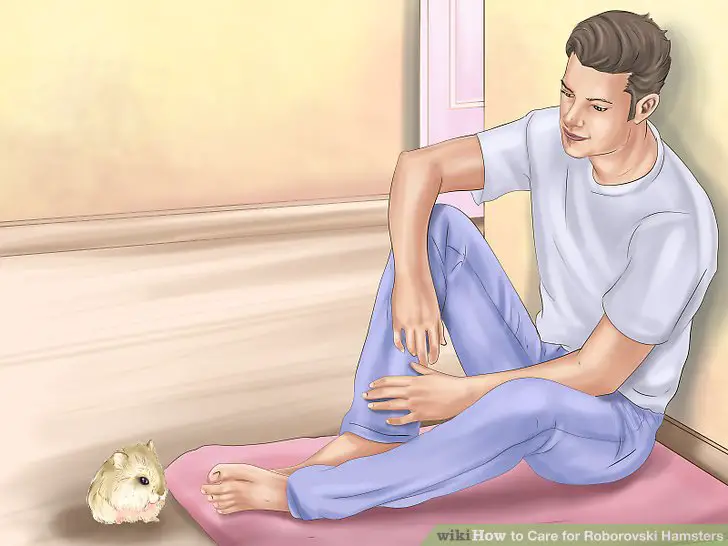
6Sit down when handling your hamster. If your hamster does start showing signs of comfort around you, then you can begin handling and playing with it. They generally have poor eyesight, so your hamster may accidentally jump from your hands at times. You should sit down, so the hamster doesn’t fall from a dangerous height.
- You should additionally always use two cupped hands when handling your hamster to prevent accidental falls.
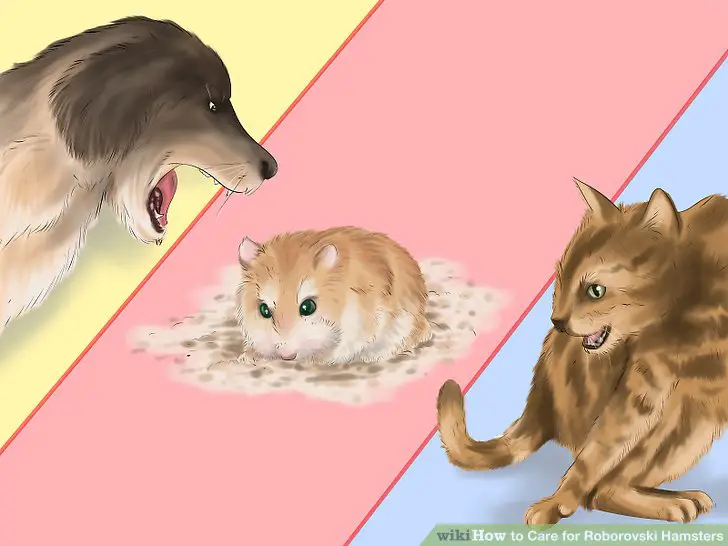
7Keep your hamster away from other household pets, such as cats and dogs.Your hamster will see them as a threat and become stressed, even if it is in the safety of its habitat. The stress opens the door to illness, and this is not good. Keep other household pets away from the room in which your hamster is kept.
Source: wikihow.com
You should find out more about the foods for them in “Hamster Diet Chart” or Hamster Food
